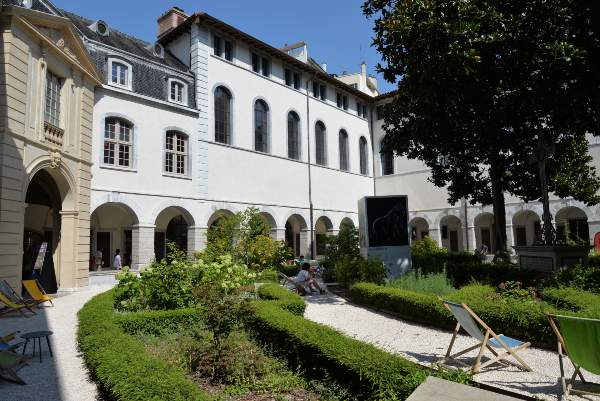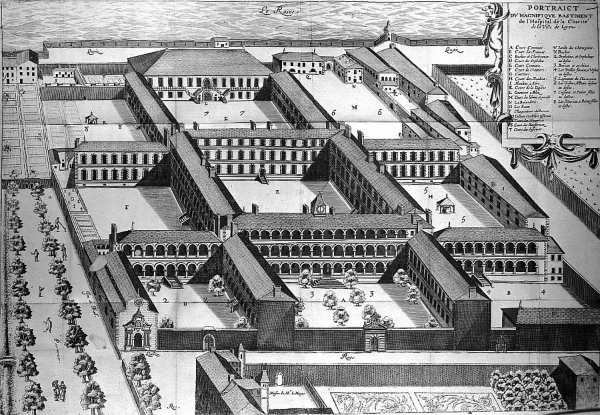- Hospital Square, 69002 Lyon
- What you see
- What you need to know
I invite you to go to the Place de l'Hôpital. As you approach the entrance door to the cloister of the Hôtel-Dieu, take a moment to contemplate the remarkable details that decorate it. In the center of the tympanum, you will notice a medallion representing Christ's descent from the cross. Above him, Mary, his mother, is depicted in a state of deep affliction.
Once you have passed through the door, take the time to look up to contemplate the majestic dome that overlooks the cloister. A remarkable work of the 17th century, this dome was designed by the architect Delamonce.
Passing through this door loaded with symbolism, you will enter the cloister of the Hôtel-Dieu, the oldest place in the hospital, as you can see on the scenographic plan of 1550. In the heart of a garden decorated with box trees and crossed by circular paths, a cross surrounded by two magnolias attracts attention. This cross, dated the year 1813 in Roman numerals, pays homage to the administrators and benefactors of the hospices, in particular to Sister Olard.
In the 12th century, the Grand Hôtel-Dieu de Lyon was founded on the initiative of the clergy. At first, it was intended as a haven of peace and assistance for the most needy, offering refuge and welcome to pilgrims and the destitute passing through. Over time, its vocation expanded to include medical care, reflecting the changing needs of Lyon society.
The Hôtel-Dieu de Lyon, near the Pont de la Guillotière, was created on the initiative of the bourgeois of Lyon around the year 1000. They called upon the Order of Pontiff Brothers, who built bridges and hospices. The first house, named the Pont du Rhône hospital, became the ancestor of the Hôtel-Dieu de Lyon.
After the establishment of the first pilgrims' house near the Pont de la Guillotière, medieval hospitals in Lyon were often small in capacity, unable to meet the growing needs of the population. However, the importance of providing health care to the community only grew over time. Thus, under the impetus of the aldermen of Lyon, among whom were eminent figures such as Gadagne and Symphorien Champier, the project of building a large hospital took shape.
This major project was born on the site of the current chapel, giving birth to the Hôpital de Notre-Dame de la Pitié du Pont-du-Rhône, more commonly known as the Grand Hôtel-Dieu. This new institution represented a significant leap in the capacity and quality of care offered, thus marking an important step in the history of medical assistance in Lyon.
In the 16th century, in 1532, an emblematic figure of French literature, François Rabelais, was appointed doctor of the hospital. At that time, the Hôtel-Dieu was largely managed by nuns, about twenty of whom were dedicated to serving the sick and the needy. At the level of the second arcade of the cloister (starting from the right when entering), take the time to observe the medallion as well as the commemorative plaque that recall François Rabelais' passage as a doctor. In addition, you can discover one of his quotes engraved on a chest located in the garden (opposite the first arcade).
"...time ripens all things; by time all things come to light; time is the father of truth."
However, Rabelais's career at the Hôtel-Dieu was cut short abruptly in 1535. He left his post suddenly, probably due to the Affair of the Placards, a significant political-religious event of the time that led to a severe crackdown on Protestant reformers in France.
In the 18th century, the Grand Hôtel-Dieu reached its peak, becoming a symbol of the excellence of Lyon's medicine. Its reputation extended well beyond the city's borders, attracting patients seeking quality care and innovative treatments. The medical advances made at this time, combined with the devotion of the hospital staff, helped to strengthen the establishment's reputation as a place of healing and comfort.
- Archive images
- Listed monument
This building is classified as a historical monuments of France. It is listed in the Merimee base, database on French architectural heritage of Ministry of Culture, under the reference PA00117821
- Your comments








